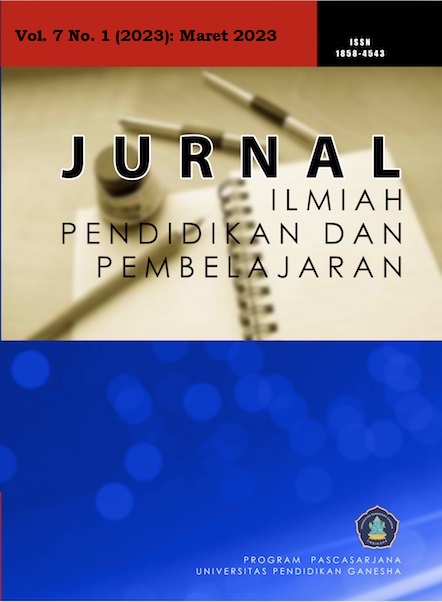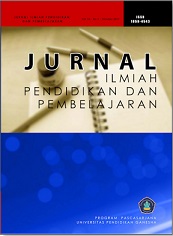Kebutuhan Terhadap Laboratorium Virtual Berbasis Masalah pada Materi Sistem Peredaran Darah
DOI:
https://doi.org/10.23887/jipp.v7i1.57970Keywords:
Analisis kebutuhan, Laboratorium virtual, Laboratorium berbasis masalahAbstract
Pembelajaran Biologi yang bermakna memerlukan suatu pembelajaran yang dilaksanakan percobaan langsung atau disebut dengan praktikum dalam proses pembelajarannya. Kurangnya sarana dan prasarana di laboratorium mengakibatkan kendala dalam pelaksanaan praktikum di sekolah. Perkembangan teknologi dapat digunakan oleh guru untuk memberikan solusi terhadap permasalahan pada praktikum Biologi yaitu dengan menggunakan laboratorium virtual. Penelitian ini bertujuan untuk melakukan analisis kebutuhan pengembangan laboratorium virtual berbasis masalah pada materi sistem peredaran darah. Metode penelitian yang digunakan adalah deskriptif kualitatif dengan teknik pengumpulan data menggunakan observasi, angket dan wawancara. Subjek penelitian adalah 5 orang guru Biologi dan 64 siswa kelas XI MIPA salah satu Madrasah Negeri di Kabupaten Bogor, Indonesia. Tahap analisis kebutuhan terdiri dari penilaian kebutuhan dan analisis kebutuhan. Analisis kebutuhan dilakukan dengan melihat kesenjangan dan kebutuhan terhadap laboratorium virtual oleh siswa dan guru. Hasil penelitian ini menunjukkan bahwa perlu adanya pengembangan laboratorium virtual berbasis masalah pada materi sistem peredaran darah untuk mendukung proses pembelajaran Biologi pada siswa.
References
Ahmadi, F. (2017). Guru SD di era digital: pendekatan, media, inovasi.
Amin, S., & Nurhadi, A. (2020). Urgensi analisis kebutuhan diklat dalam meningkatkan kompetensi guru PAI dan budi pekerti. Jurnal Manajemen Pendidikan Islam, 3(2), 83–100. https://doi.org/10.30868/im.v3i2.871.
Andalia, N., Ridhwan, M., Roslina, R., Afni, N., & AG, B. (2019). Implementation of Inquiry Method on Students’ Critical Thinking Ability in the Concept of Structure and Function of Plant Networks. International Journal for Educational and Vocational Studies, 1(4), 373–378. https://doi.org/10.29103/IJEVS.V1I4.1784.
Aripin, I., & Suryaningsih, Y. (2021). The development of prototype virtual laboratory through biology, technology, engineering, and mathematics (BTEM). Journal of Physics: Conference Series, 1806(1), 012171. https://doi.org/10.1088/1742-6596/1806/1/012171.
Aripin, Ipin, & Suryaningsih, Y. (2020). Developing BTEM-Based Virtual Biology Laboratory to Improve Students ’ Critical Thinking Skills on the Concept of Bacteria. 9, 216–227.
Asrizal, A., Hendri, A., Hidayati, H., & Festiyed, F. (2018). Penerapan Model Pembelajaran Penemuan Mengintegrasikan Laboratorium Virtual dan Hots untuk Meningkatkan Hasil Pembelajaran Siswa SMA Kelas XI. Jurnal Pds Unp, 1(1), 49–57. http://pdsunp.ppj.unp.ac.id/index.php/PDSUNP/article/view/9.
Asrizal, Asrizal, Hendri, A., & Festiyed, F. (2019). Penerapan Model Pembelajaran Penemuan Mengintegrasikan Laboratorium Virtual dan Hots untuk Meningkatkan Hasil Pembelajaran Siswa SMA Kelas XI. November, 49–57. https://doi.org/10.31227/osf.io/bknrf.
Bunyamin, E. M., Siregar, E. S., & Kusumawardani, D. K. (2021). Need Analysis of Virtual Laboratory for Vocational School Learning Practices During Covid-19 Pandemic. Journal of Education Research and Evaluation, 5(2), 192–199. https://doi.org/10.23887/JERE.V5I2.32293.
Candra, R., & Hidayati, D. (2020). Penerapan Praktikum dalam Meningkatkan Keterampilan Proses dan Kerja Peserta Didik di Laboratorium IPA. Jurnal Kependidikan Dan Sosial Keagamaan, 6(1), 26–37. https://doi.org/10.32923/edugama.v6i1.1289.
Dyrberg, N. R., Treusch, A. H., & Wiegand, C. (2017). Virtual laboratories in science education: students’ motivation and experiences in two tertiary biology courses. Journal of Biological Education, 51(4), 358–374. https://doi.org/10.1080/00219266.2016.1257498.
Faour, M. A., Ayoubi, Z., & Faour, Malak Abou; Ayoubi, Z. (2018). The Effect of Using Virtual Laboratory on Grade 10 Students’ Conceptual Understanding and their Attitudes towards Physics. Journal of Education in Science, Environment and Health, 4(1), 54–68. https://doi.org/10.21891/jeseh.387482.
Ferreira, et al. (2010). Collaborative learning based on a micro-webserver remote test controller.
Harjono, A., Sahidu, H., & Herayanti, L. (2017). Virtual Laboratory Of Electricity Concept To Improve Prospective Physics Teachers’ Creativity. Jurnal Pendidikan Fisika Indonesia, 13(2), 102–111. https://doi.org/10.15294/jpfi.v13i2.10152.
Irdalisa, et al. (2022). Technological Pedagogical Content Knowledge: Ability Prospective Teachers Biology Education Department In Jakarta Indonesia. International Journal of Educational Research Review, 114–123. https://doi.org/10.24331/ijere.1050594.
Junita, A., Supriatno, B., & Purwianingsih, W. (2021). Profil keterampilan kolaborasi siswa SMA pada praktikum maya sistem ekskresi. Assimilation: Indonesian Journal of Biology Education, 4(2), 50–57. https://doi.org/10.17509/AIJBE.V4I2.41480.
Kusuma, I. P. I. (2020). Mengajar bahasa Inggris dengan teknologi: Teori dasar dan ide pengajaran.
Major, S., Hubálovská, M., & Loskot, R. (2022). Alternative Forms of Laboratory Teaching during the Lockdown Period Caused by the COVID-19 Pandemic. International Journal of Information and Education Technology, 12(11), 1737–1747. https://doi.org/10.18178/ijiet.2022.12.11.1731.
Makransky, G., Mayer, R. E., Veitch, N., Hood, M., Christensen, K. B., & Gadegaard, H. (2019). Equivalence of using a desktop virtual reality science simulation at home and in class. PLoS ONE, 14(4), 1–14. https://doi.org/10.1371/journal.pone.0214944.
Nirmala, W., & Darmawati, S. (2021). The Effectiveness of Discovery-Based Virtual Laboratory Learning to Improve Student Science Process Skills. Journal of Education Technology, 5(1), 103–112. https://doi.org/10.23887/JET.V5I1.33368.
Nisak, N. Z. (2021). Analisis Kebutuhan Bahan Ajar Biologi untuk Siswa SMA Ditinjau dari Tingkat Kesulitan Materi, Keterampilan Berpikir Tingkat Tinggi, dan Keaktifan Belajar Siswa. EduBiologia: Biological Science and Education Journal, 1(2), 128–133. https://doi.org/10.30998/edubiologia.v1i2.9629.
Orobor, A. I., & Orobor, H. E. (2020). a Review of Virtual Laboratory and Justification for Adoption in Nigeria Tertiary Educational Institutions. International Journal of Open Information Technologies, 8(2), 47–53.
Putra, E. A., Sudiana, R., & Pamungkas, A. S. (2020). Pengembangan Smartphone Learning Management System (S-LMS) sebagai media pembelajaran matematika di SMA. Jurnal Matematika Kreatif-Inovatif, 11(1), 36–45. https://doi.org/10.15294/kreano.v11i1.21014.
Putri, L. A., Permanasari, A., Winarno, N., & Ahmad, N. J. (2021). Enhancing Student Scientific Literacy using Virtual Lab Activity with Inquiry-Based Learning. Journal of Science Learning, 4(2), 173–184. https://doi.org/10.17509/jsl.v4i2.27561.
Rahim, F. R., Suherman, D. S., & Murtiani, M. (2019). Analisis Kompetensi Guru dalam Mempersiapkan Media Pembelajaran Berbasis Teknologi Informasi Era Revolusi Industri 4.0. Jurnal Eksakta Pendidikan (Jep), 3(2), 133–141. https://doi.org/10.24036/jep/vol3-iss2/367.
Rahmawati, D. N., Zahro, L., & Hidayatullah, A. F. (2021). Pembelajaran Praktikum pada Mahasiswa Prodi Biologi dan Pendidikan Biologi Universitas Islam Negri Walisongo Semarang di Masa Pandemi Covid-19. Indonesian Journal of Science Learning (IJSL), 2(2), 109–116. https://doi.org/10.15642/IJSL.V2I2.1238.
Reny, Sugiarti, & Salempa, P. (2018). Pengembangan Laboratorium Virtual Berbasis Multimedia Interaktif pada Pembelajaran Titrasi Asam Basa. Chemistry Education Review (CER), 2(1), 32–41.
Sari*, R. T., Angreni, S., & Salsa, F. J. (2022). Pengembangan Virtual-Lab Berbasis STEM Untuk Meningkatkan Keterampilan Berpikir Kritis Mahasiswa. Jurnal Pendidikan Sains Indonesia, 10(2), 391–402. https://doi.org/10.24815/jpsi.v10i2.23833.
Simbolon, D. H. (2015). Pengaruh model pembelajaran inkuiri terbimbing berbasis eksperimen riil dan laboratorium virtual terhadap hasil belajar fisika siswa. Jurnal Pendidikan Dan Kebudayaan, 21(3), 299–316. https://doi.org/10.24832/jpnk.v21i3.192.
Sitio, S., Silalahi, M. V., & Silaen, S. (2022). Pengaruh model pembelajaran project based learning dan problem based learning pada materi termokimia terhadap prestasi belajar siswa kelas XI SMA Negeri 1 … E Desnylasari, S Mulyani, B Mulyani - Jurnal Pendidikan Kimia, 2016 - jurnal.fkip. Jurnal Pendidikan Dan Konseling (JPDK), 4(6), 2965–2976. https://doi.org/10.31004/jpdk.v4i6.8671.
Solikhin, F., Ikhsan, J., & Sugiyarto, K. H. (2019). A need analysis in developing virtual laboratory according to the chemistry teachers. Journal of Physics: Conference Series, 1156(1). https://doi.org/10.1088/1742-6596/1156/1/012020.
Sommer, B. A., & Sommer, R. (2019). A Virtual Lab in Research Methods. Teaching of Psychology, 30(2), 171–173. https://doi.org/10.1207/S15328023TOP3002_16.
Stahre Wästberg, B., Eriksson, T., Karlsson, G., Sunnerstam, M., Axelsson, M., & Billger, M. (2019). Design considerations for virtual laboratories: A comparative study of two virtual laboratories for learning about gas solubility and colour appearance. Education and Information Technologies, 24(3), 2059–2080. https://doi.org/10.1007/s10639-018-09857-0.
sugiyono. (2012). metode penelitian kuantitatif kualitatif dan r&d. In Bandung Alf.
Sukenti, E. (2021). Pengembangan Laboratorium Virtual Untuk Meningkatkan Penguasaan Konsep Pada Materi Sistem Sirkulasi. Pedagonal : Jurnal Ilmiah Pendidikan, 5(1), 1–6. https://doi.org/10.33751/pedagonal.v5i1.2572.
Verawati, N. N. S. P., Handriani, L. S., & Prahani, B. K. (2022). The Experimental Experience of Motion Kinematics in Biology Class Using PhET Virtual Simulation and Its Impact on Learning Outcomes. International Journal of Essential Competencies in Education, 1(1), 11–17. https://doi.org/10.36312/ijece.v1i1.729.
Wang, F. (2018). Computer distance virtual experiment teaching application based on virtual reality technology. International Journal of Emerging Technologies in Learning, 13(4), 83–94. https://doi.org/10.3991/ijet.v13i04.8472.
Winarni, D. S. (2020). Effectiveness of Virtual Anatomy System (VAS) Media to Improve Students’ Analysis Ability Towards Reproduction System Materials. Indonesian Journal of Science and Education, 4(1), 43–47. https://doi.org/10.31002/IJOSE.V4I1.1422.
Downloads
Published
How to Cite
Issue
Section
License
Copyright (c) 2023 Yulia Ramdinawati Syam

This work is licensed under a Creative Commons Attribution-ShareAlike 4.0 International License.
Authors who publish with the Jurnal Ilmiah Pendidikan dan Pembelajaran (JIPP) agree to the following terms:
- Authors retain copyright and grant the journal the right of first publication with the work simultaneously licensed under a Creative Commons Attribution License (CC BY-SA 4.0) that allows others to share the work with an acknowledgment of the work's authorship and initial publication in this journal.
- Authors are able to enter into separate, additional contractual arrangements for the non-exclusive distribution of the journal's published version of the work (e.g., post it to an institutional repository or publish it in a book), with an acknowledgment of its initial publication in this journal.
- Authors are permitted and encouraged to post their work online (e.g., in institutional repositories or on their website) prior to and during the submission process, as it can lead to productive exchanges, as well as earlier and greater citation of published work. (See The Effect of Open Access)










